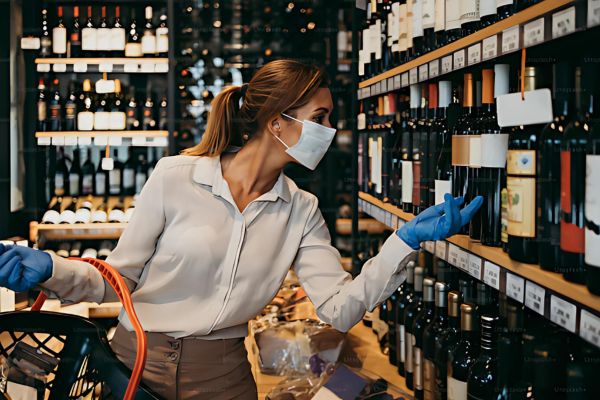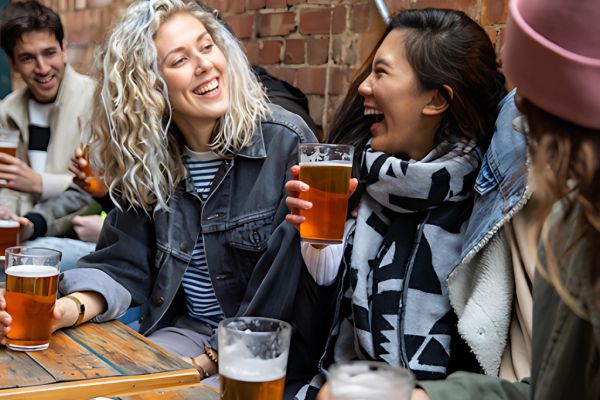
08/02/2024 Navigating the Spirits Landscape: Join us as we talk about specific trends, categories, and market dynamics of the alc-bev industry with IWSR’s COO Emily Neill.
In the dynamic realm of data analytics and market insights, Emily Neill stands out as a luminary, bringing her wealth of experience and expertise to the forefront. As the Chief Operating Officer at The IWSR, Emily has curated a distinguished career marked by a proven track record in building business intelligence databases and analysis tools. With a focus on market research, product development, and strategy consulting in the consumer goods industry, she has played a pivotal role in driving operational excellence and profitability. In this exclusive interview, we delve into Emily's insights, exploring the intricacies of global beverage alcohol trends through data-based market research from The IWSR.
Premiumization in Uncertain Times: In the wake of economic fragility, how do you foresee the premiumization trend evolving, especially with a broader base of "mass affluent" consumers coming into play?

The long-running premiumization trend in beverage alcohol has weakened significantly, as consumers felt the full impact of economic pressures and geopolitical uncertainty. Key trends fuelling the deceleration include the slowing of premium-and-above agave expansion in the US, losses across the wine category – including Champagne – and softer growth for high-end beer in markets such as Brazil and Spain. Nevertheless, pockets of premiumization endure in Asia in particular, with high-end baijiu performing well in China, and markets such as India, the Philippines, and Thailand recording dynamic growth in high-end spirits consumption. Meanwhile, beer was boosted by the reopening on-premise in China and trading up in the UK, US, and Mexico. In the longer term, the premiumization trend looks to be structural in many parts of the beverage alcohol market – and it is likely to withstand shorter-term economic and geopolitical turbulence, as it has done in the past.
China's Spirits Market Dynamics: With the US and India poised for strong spirits growth, how do you see China's risk profile evolving, considering factors like government policies and changing consumer preferences?
Volume growth in China will be more subdued than in the past, however, China will remain a significant value driver for the global beverage alcohol market. IWSR forecasts that total alcohol volumes in China will fall between 2022 and 2027, at a CAGR of -0.4%, but this decline masks the ongoing premiumization trend, with the value of the market expected to grow by US$41.7bn over the same timescale. While spirits as a whole are forecast to contract, the dominant baijiu category is entirely responsible for that decline – particularly at the lower-priced end. All other major spirits categories – including whisky, gin/genever, vodka, agave, rum, and brandy – are forecast to grow sales volumes by healthy single-digit CAGRs. Growth is expected at the premium-plus price segment for beer, and RTDs are also expected to see healthy growth.

Beer's Growth Trajectory: What specific factors contribute to the promising growth opportunities for beer in markets like India, Latin America, and Africa, and how does this compare to the decline in traditional beer consumption in China and the US?
In emerging markets such as India, Latin America, and Africa, the growth trajectory for beer is typically more buoyant, aided by expanding LDA consumers, advancing middle-class populations, and increased urbanization. Transformation in retail experiences has also helped to propel growth in India as consumers opt to trade up.
In recent years, these regions have seen significant investment from global brewers as they look to expand their footprint and capitalize on these trends, with a more premium offering. For example, in 2021, Heineken obtained a controlling interest in United Breweries in India, and in 2023 acquired Distell and Namibia Breweries to expand their African presence. In LATAM, AB-InBev (Bavaria) announced in early 2023 that it would construct a brewery in Northern Colombia investing $413m. Heineken has also been actively investing in its Brazilian operations since it acquired them from Kirin Holdings in 2017. In 2022, Constellation Brands announced it would invest approximately $ 1.2 billion in its Mexico operations in the 2024 fiscal year.

Conversely, in more developed markets like the US, the beer market is facing several headwinds. In addition to tough economic conditions, on trade recovery and inflationary pressures, expanding consumer repertories and a change from 'category led' to 'occasion led' consumption, means consumers are increasingly choosing non-beer products, such as RTDs, for occasions that were historically beer-led. The outlook for China is also more subdued as consumers remain hesitant, due to increased uncertainty around their finances and a weaker-than-expected bounce-back from Covid. Globally, beer consumption is expected to remain broadly flat for the forecast period 2022-2027, although the outlook for premium-and-above beer is more positive with compound annual growth forecast at around 3%.
Sparkling Wine's Resilience: Despite the overall decline in the wine category, sparkling wines like Prosecco and Champagne continue to grow. What factors drive this growth, and how have consumer attitudes toward sparkling wines shifted?
Sparkling wine is one of the bright spots in the global wine industry, with sparkling wine moving away from exclusive association with formal events and special occasions, to one that can be enjoyed in more relaxed contexts and more frequently. Lockdowns during COVID-19 contributed to this trend: the lack of big, formal celebratory occasions led to Prosecco and Champagne, in particular, being drunk more informally at home, and consumers have reassessed their attitude to the category as a result. The on-premise is also helping to broaden the opportunities for everyday celebrations involving sparkling wine – whether on its own, through the brunch occasion, or cocktail culture.

Rise of Premium RTDs: The RTD category has seen a shift to premium products. Can you elaborate on the factors contributing to the rise of premium RTDs, and how this impacts consumer preferences globally?
IWSR data shows that the RTD category is expected to grow by +12% in volume between 2022 and 2027, hitting $40bn by 2027 across 10 key markets (that account for over 80% of global RTD volumes).
This growth will be driven by the key cocktails/long drinks sub-category and products that sit within the premium-and-above price bracket. This outlook marks a slowdown from previous years, primarily due to volume declines in hard seltzers in the US.
Innovation in RTDs is increasingly skewing to premium price points, thanks to trends such as spirit-based hard seltzers; using named spirits categories and premium ingredients in RTDs; and enhancing products with functional ingredients. As a shift from lighter to fuller flavors continues, brand owners are increasingly focusing on products with higher ABVs, with IWSR research showing that 32% of RTD consumers consider alcoholic strength when selecting a product.
Apart from the influence of alcohol strength, other factors that are important to RTD choice include flavor, alcohol base, type of cocktail/long drink, and price. Interestingly, there are signs that consumers are becoming less influenced by brands: only 29% said the brand was important to their choice of RTD.
E-commerce Trends: While alcohol e-commerce experienced rapid growth during the pandemic, how do you see it evolving in the post-pandemic era? What factors contribute to the expected growth, and which beverage categories are likely to dominate online sales?
IWSR’s ongoing assessment of the alcohol e-commerce channel shows that beverage alcohol e-commerce is entering a period of normalization following the Covid boom and subsequent post-pandemic correction, with sales in the world’s leading 16 markets expected to grow at a slower pace to reach just under US$40bn by 2027. That represents a 2022-27 value CAGR of +4.5% – compared to the +31% CAGR recorded between 2019 and 2021. Nevertheless, this growth is expected to outpace total beverage alcohol across the 16 markets (on-trade plus bricks-and-mortar off-trade plus e-commerce), which is expected to see a value CAGR 2022-27 of under 2%.
In the post-Covid environment, the behavior of alcohol buyers is evolving in different directions. The overall proportion of consumers shopping online is down, but those who continue to do so are increasing their frequency. This indicates that the channel is shedding ‘transient’ users who only adopted it out of necessity during the pandemic, but also maintaining or even gaining appeal among ecommerce loyalists.
Our data also shows that online alcohol shoppers spend significantly longer carrying out pre-purchase research than those buying in brick-and-mortar retail or on-premise. The extent of this pre-purchase research, the sources used, and the information sought, however, vary by market and demographic.
Regarding growth drivers, China and the US remain the biggest drivers of absolute value growth for alcohol in e-commerce. When looking at category dynamics, spirits’ share of e-commerce alcohol has recovered from its pandemic dip and is now expected to stabilize, while beer is expected to expand the fastest, largely stealing share from the more mature and lower-growth wine category.

Source: IWSR
While more modest growth is now expected to come from online alcohol sales in the future, with a corresponding return to more traditional purchasing channels, e-commerce should nonetheless remain a key priority for brand owners.
Home Premise Occasion: Economic concerns are driving a stronger focus on the at-home occasion. How do you see this trend impacting the on-trade recovery, and what innovations have emerged in the home premise occasion?
The home premise grew during the pandemic, with consumers investing in the at-home experience, improving their mixology skills, socializing with friends at home, and installing at-home bars for entertainment.
Although many bars and restaurants around the world bounced back in 2022 following the lockdown-induced lows of 2021, IWSR data shows that most markets have yet to see their on-premise share of overall alcohol consumption reach pre-pandemic levels.
However, there is a strong contrast between Western and Asian countries when it comes to consumer attitudes to the on-premise, driven by several factors, including the macroeconomic climate and cultural attitudes towards socializing. As a result, the staying power of the at-home occasion varies greatly by geography.
Moderation Trends: The trend of moderation is evolving, influenced not only by health concerns but also economic worries. How do you see consumers adapting to this trend, and what are the implications for the alcoholic beverage industry?
The trend for moderation is largely driven by lifestyle and wellness choices, with some consumers choosing to drink less alcohol overall, or opting to change their intensity/frequency of consumption. However, reduced disposable incomes are also playing a key role in prompting some consumers to re-evaluate their alcohol spend.
For brand owners, moderation is an established trend, and no-alcohol products that keep customers within a category (eg: switching beer for no-alcohol beer) or brand portfolio (eg: Switching a Heineken for Heineken 0.0) offer an option to hold on to revenue and continue to build brand equity.

Source: IWSR
The no-alcohol category continues to gain consumer interest. Almost a fifth (17%) of all no-alcohol consumers in 2023 were new entrants. Younger LDA cohorts are recruited the most across markets, with fewer Boomers entering the category.
IWSR data shows that new entrants to no/low are also driving increased consumption frequency. While roughly half of new entrants are frequent no/low purchasers, for ‘experienced’ consumers the figure is less than 40% – and new entrants are more likely to look to increase their no/low consumption in the future.
Future growth in no-alcohol will be spearheaded by less developed no-alcohol markets, such as Canada, the US, Australia, and Brazil.
[[relatedPurchasesItems-31]]
Conclusion:
As we conclude our conversation with Emily Neill, it becomes evident that her leadership as the Chief Operating Officer at The IWSR is instrumental in ensuring the organization remains a trusted source for beverage alcohol trends. With an unwavering commitment to accuracy and innovation, Emily continues to guide The IWSR as the trusted source for benchmarking performance and identifying market opportunities. Through her extensive experience and strategic vision, Emily exemplifies the essence of decoding market dynamics, providing invaluable insights for industry stakeholders navigating the ever-evolving world of beverage alcohol.
In conversation with Malvika Patel, Editor and VP, Beverage Trade Network



